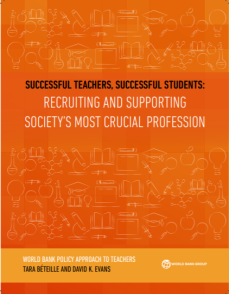
 Teacher salaries are a point of contention in many countries. But a particular problem in low-income countries is that salary payments will sometimes be delayed for lengthy periods. Ba’bila Mutia’s exciting novel The Journey’s End centers around salary arrears. (No, that’s not an oxymoron.) At the book’s opening, a retired school principal arrives in Cameroon’s capital city, Yaoundé, to seek several years worth of pension payments. His first evening, he meets a younger man who advertises himself as a diviner but who provides detailed assistance on how to navigate the public bureaucracy. As we learn the younger man’s backstory, we find that years before, he arrived in Yaoundé in search of his teacher salary arrears, which he needed to pay his bride price. But in the capital, his life took a dark turn.
Teacher salaries are a point of contention in many countries. But a particular problem in low-income countries is that salary payments will sometimes be delayed for lengthy periods. Ba’bila Mutia’s exciting novel The Journey’s End centers around salary arrears. (No, that’s not an oxymoron.) At the book’s opening, a retired school principal arrives in Cameroon’s capital city, Yaoundé, to seek several years worth of pension payments. His first evening, he meets a younger man who advertises himself as a diviner but who provides detailed assistance on how to navigate the public bureaucracy. As we learn the younger man’s backstory, we find that years before, he arrived in Yaoundé in search of his teacher salary arrears, which he needed to pay his bride price. But in the capital, his life took a dark turn.
The Journey’s End has secret village societies, urban prostitution rings, crime lords, illicit fuel sales, and a tiny bit of magic. But it centers on government bureaucracy and corruption. Much of the book’s climax is dedicated to a retiree ascending and descending stairs in a government building, nudging his file along with a small payment here and there. Mutia manages to captivate (almost) throughout.
I had a few quibbles: The book needed a copy edit, and one twist in the last two pages didn’t quite ring true to me. But neither of those stopped me from enjoying Mutia’s twisty-turny saga.
This is book #23 in my effort to read a book by an author from every African country in 2019.


 Over the course of last year, I worked closely with counterparts in the Government of Rwanda to map what human capital investments would be most likely to lead to high economic growth in the coming decades. It was a satisfying, collaborative process, and it felt like our findings on the quality of education reached high levels of government decisionmaking.
Over the course of last year, I worked closely with counterparts in the Government of Rwanda to map what human capital investments would be most likely to lead to high economic growth in the coming decades. It was a satisfying, collaborative process, and it felt like our findings on the quality of education reached high levels of government decisionmaking.















